A Modified Surface Energy Balance to Estimate Crop Transpiration and Soil Evaporation in Micro-Irrigated Orchards
Abstract
1. Introduction
2. Materials and Methods
2.1. The Modified SEB-PW Model
2.2. SEB-PW Model Parameters
2.2.1. Aerodynamic Resistances
2.2.2. Canopy Resistances
2.2.3. Soil Resistances
2.2.4. Net Radiation
2.3. Model Evaluation
2.3.1. Study Sites
2.3.2. Micrometeorological and Surface Renewal Measurements
2.3.3. Soil Evaporation
3. Results and Discussion
3.1. Sensitivity Analysis
3.1.1. Soil Resistances to Vapor Flux
3.1.2. Vapor Pressure Deficit, Canopy Resistance and Air Temperature
3.2. Preliminary Model Evaluation
3.2.1. Evapotranspiration and Soil Evaporation Measurement Field Campaign
Environmental, and Conditions at the S1 and S2 Sites
Surface Energy Balance Measurements
Model Performance
Daily Soil Evaporation
4. Conclusions
Author Contributions
Funding
Acknowledgments
Conflicts of Interest
Appendix A. Mathematical Treatment and Additional Information
| Variable | Range Value | Unit |
|---|---|---|
| 600 | W m−2 | |
| 25–35 | °C | |
| 30–70 | % | |
| 1–3 | m s−1 | |
| 16–25 | °C | |
| 4 | m2 m−2 | |
| 0.05 | m | |
| 0.5 | m | |
| 0.4–0.8 | Adimensional | |
| 1000 | W m−2 | |
| 700 | W m−2 | |
| 0.5 | Adimensional | |
| 0.3–0.7 | Adimensional | |
| , and | 4.2, 0.0025 and 350 | Adimensional |
| and | 1.2 and 5.1 | s m−1 and adimensional |
| 1.25–2.75 | kPa |
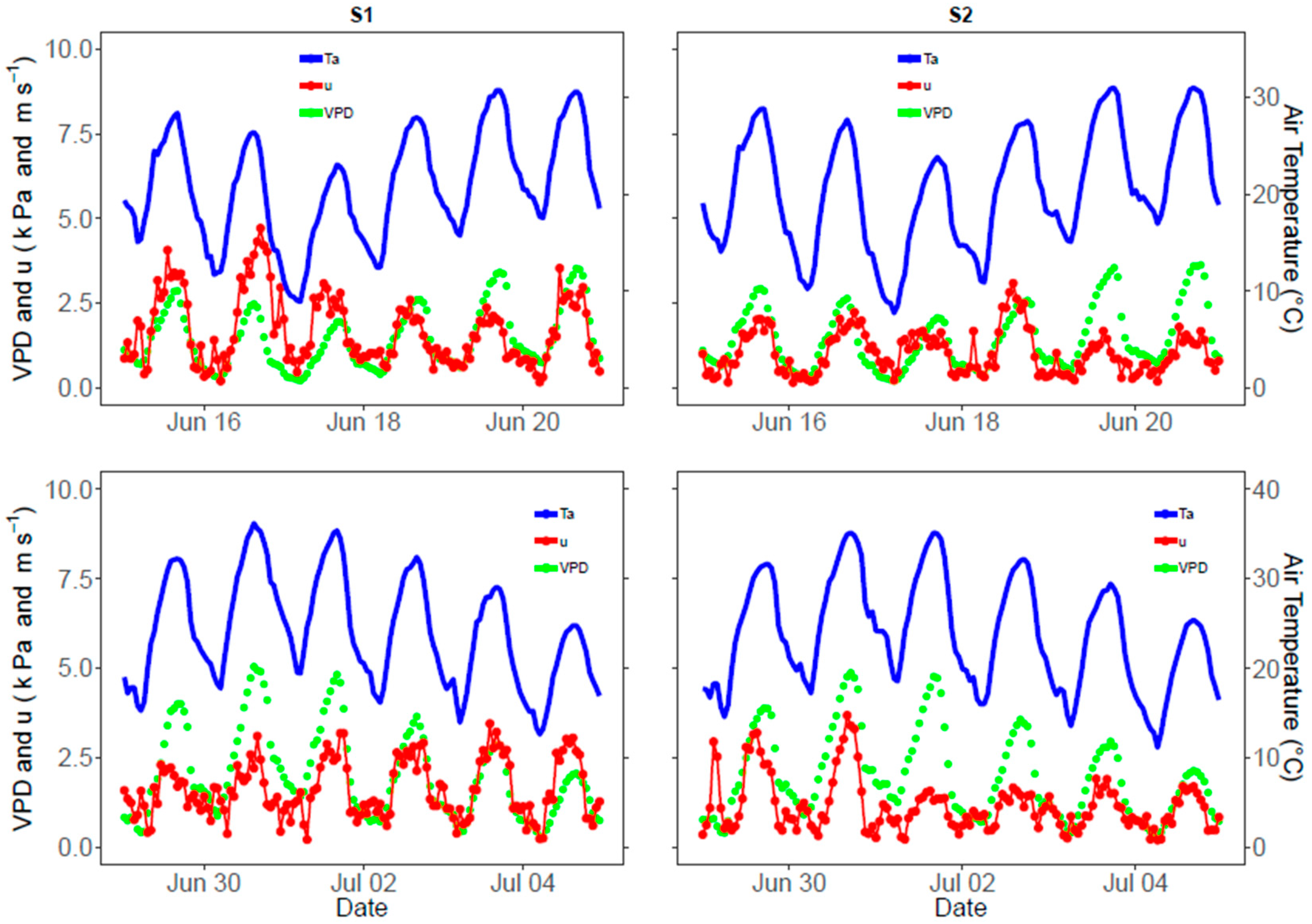
| North Station | South Station | |||||
|---|---|---|---|---|---|---|
| Date | (%) | (%) | (m2/m2) | (%) | (%) | (m2/m2) |
| 15-June | 39 | 45 | 2.4 | 30 | 31 | 1.8 |
| 16-June | 41 | 26 | ||||
| 17-June | 35 | 18 | ||||
| 18-June | 21 | 12 | ||||
| 19-June | 10 | 10 | ||||
| 20-June | 5 | 5 | ||||
| 29-June | 41 | 50 | 2.5 | 31 | 38 | 1.8 |
| 30-June | 46 | 32 | ||||
| 1-July | 37 | 22 | ||||
| 2-July | 21 | 10 | ||||
| 3-July | 10 | 7 | ||||
| 4-July | 5 | 5 | ||||
References
- Reitz, M.; Senay, G.B.; Sanford, W.E. Combining remote sensing and water-balance evapotranspiration estimates for the conterminous United States. Remote Sens. 2017, 9, 1181. [Google Scholar] [CrossRef]
- Lagos, L.O.; Martin, D.L.; Verma, S.B.; Suyker, A.; Irmak, S. Surface energy balance model of transpiration from variable canopy cover and evaporation from residue-covered or bare-soil systems. Irrig. Sci. 2009, 28, 51–64. [Google Scholar] [CrossRef]
- Wang, D.; Wang, L. Dynamics of evapotranspiration partitioning for apple trees of different ages in a semiarid region of northwest China. Agric. Water Manag. 2017, 191, 1–15. [Google Scholar] [CrossRef]
- Burt, C.M.; Mutziger, A.J.; Allen, R.G.; Howell, T.A. Evaporation research: Review and interpretation. J. Irrig. Drain. Eng. 2005, 131, 37–58. [Google Scholar] [CrossRef]
- Campbell, G.S.; Norman, J.M. An Introduction to Environmental Biophysics; Springer Science & Business Media: Berlin/Heidelberg, Germany, 2012. [Google Scholar]
- Idso, S.B.; Reginato, R.J.; Jackson, R.D.; Kimball, B.A.; Nakayama, F.S. The three stages of drying of a field soil. Soil Sci. Soc. Am. J. 1974, 38, 831–837. [Google Scholar] [CrossRef]
- Deol, P.; Heitman, J.; Amoozegar, A.; Ren, T.; Horton, R. Quantifying nonisothermal subsurface soil water evaporation. Water Resour. Res. 2012, 48, 1–11. [Google Scholar] [CrossRef]
- Boast, C.W.; Robertson, T.M. A “Micro-Lysimeter” Method for Determining Evaporation from Bare Soil: Description and Laboratory Evaluation1. Soil Sci. Soc. Am. J. 1982, 46, 689. [Google Scholar] [CrossRef]
- Evett, S.R.; Warrick, W.; Matthias, D. Wall Material and Capping Effects on Microlysimeter Temperatures and Evaporation. Soil Sci. Soc. Am. J. 1995, 59, 329. [Google Scholar] [CrossRef]
- Todd, R.W.; Evett, S.R.; Howell, T.A.; Klocke, N.L. Soil temperature and water evaporation of small steel and plastic lysimeters replaced daily. Soil Sci. 2000, 165, 890–895. [Google Scholar] [CrossRef]
- Yunusa, I.A.M.; Walker, R.R.; Lu, P. Evapotranspiration components from energy balance, sapflow and microlysimetry techniques for an irrigated vineyard in inland Australia. Agric. For. Meteorol. 2004, 127, 93–107. [Google Scholar] [CrossRef]
- Penman, H.L. Natural evaporation from open water, bare soil and grass. R. Soc. Lond. Ser. A Math. Phys. Sci. 1948, 193, 120–145. [Google Scholar]
- Monteith, J.L. Evaporation and enviroment. Symp. Soc. Exp. Biol. 1965, 19, 205–234. [Google Scholar] [PubMed]
- Kjelgaard, J.F.; Stockle, C.O. Evaluating surface resistance for estimating Corn and Potato evapotranspiration with the Penman-Monteith model. Trans. ASAE 2001, 44, 797–805. [Google Scholar] [CrossRef]
- Ortega-Farias, S.; Olioso, A.; Antonioletti, R.; Brisson, N. Evaluation of the Penman-Monteith model for estimating soybean evapotranspiration. Irrig. Sci. 2004, 23, 1–9. [Google Scholar] [CrossRef]
- Shuttleworth, W.J. Towards one-step estimation of crop water requirements. Trans. ASABE 2006, 49, 925–935. [Google Scholar] [CrossRef]
- Shuttleworth, W.J.; Wallace, J.S. Evaporation from sparse crops-an energy combination theory. Q. J. R. Meteorol. Soc. 1985, 111, 839–855. [Google Scholar] [CrossRef]
- Farahani, H.J.; Ahuja, L.R. Evapotranspiration modeling of partial canopy/residue-covered fields. Trans. ASAE 1996, 39, 2051–2064. [Google Scholar] [CrossRef]
- Stannard, D.I. Comparison of Penman-Monteith, Shuttleworth-Wallace, and modified Priestley-Taylor evapotranspiration models for wildland vegetation in semiarid rangeland. Water Resour. Res. 1993, 29, 1379–1392. [Google Scholar] [CrossRef]
- Ortega-Farias, S.; Carrasco, M.; Olioso, A.; Acevedo, C.; Poblete, C. Latent heat flux over Cabernet Sauvignon vineyard using the Shuttleworth and Wallace model. Irrig. Sci. 2007, 25, 161–170. [Google Scholar] [CrossRef]
- Zhao, P.; Li, S.; Li, F.; Du, T.; Tong, L.; Kang, S. Comparison of dual crop coefficient method and Shuttleworth-Wallace model in evapotranspiration partitioning in a vineyard of northwest China. Agric. Water Manag. 2015, 160, 41–56. [Google Scholar] [CrossRef]
- Iritz, Z.; Lindroth, A.; Heikinheimo, M.; Grelle, A.; Kellner, E. Test of a modified Shuttleworth-Wallace estimate of boreal forest evaporation. Agric. For. Meteorol. 1999, 98, 605–619. [Google Scholar] [CrossRef]
- Odhiambo, L.O.; Irmak, S. Performance of Extended Shuttleworth-Wallace Model for Estimating and Partitioning of Evapotranspiration in a Partial Residue-Covered Subsurface Drip-Irrigated Soybean Field. Trans. ASABE 2011, 54, 915–930. [Google Scholar] [CrossRef]
- Ortega-Farí-as, S.; López-Olivari, R. Validation of a Two-Layer Model to Estimate Latent Heat Flux and Evapotranspiration in a Drip-Irrigated Olive Orchard. Trans. ASABE 2012, 55, 1169–1178. [Google Scholar] [CrossRef]
- Choudhury, B.J.; Monteith, J.L. A four-layer model for the heat budget of homogeneous land surfaces. Q. J. R. Meteorol. Soc. 1988, 114, 373–398. [Google Scholar] [CrossRef]
- Lagos, L.O.; Merino, G.; Martin, D.; Verma, S.; Suyker, A. Evapotranspiration of Partially Vegetated Surfaces. In Evapotranspiration-Remote Sensing and Modeling; InTech: London, UK, 2012. [Google Scholar]
- Allen, R.G.; Asce, M.; Pereira, L.S.; Asce, M.; Smith, M.; Raes, D.; Wright, J.L.; Asce, M. FAO-56 Dual Crop Coefficient Method for Estimating Evaporation from Soil and Application Extensions. J. Irrig. Drain. Eng. 2005, 131, 2–13. [Google Scholar] [CrossRef]
- Wilson, K.; Goldstein, A.; Falge, E.; Aubinet, M.; Baldocchi, D.; Berbigier, P.; Bernhofer, C.; Ceulemans, R.; Dolman, H.; Field, C.; et al. Energy balance closure at FLUXNET sites. Agric. For. Meteorol. 2002, 113, 223–243. [Google Scholar] [CrossRef]
- Liu, S.; Mao, D.; Lu, L. Measurement and estimation of the aerodynamic resistance. Hydrol. Earth Syst. Sci. Discuss. 2006, 3, 681–705. [Google Scholar] [CrossRef]
- Thom, A.S. 1972 Momentum, mass and heat exchange of vegetation. Q. J. R. Meteorol. Soc. 1972, 98, 124–134. [Google Scholar] [CrossRef]
- Shuttleworth, W.J.; Gurney, R.J. The theoretical relationship between foliage temperature and canopy resistance in sparse crops. Q. J. R. Meteorol. Soc. 1990, 116, 497–519. [Google Scholar] [CrossRef]
- Verma, S.B. Aerodynamic resistances to transfers of heat, mass and momentum. Estim. Areal Evapotranspir. 1989, 177, 13–20. [Google Scholar]
- Wesely, M.L.; Hicks, B.B. Some factors that affect the deposition rates of sulfur dioxide and similar gases on vegetation. J. Air Pollut. Control Assoc. 1977, 27, 1110–1116. [Google Scholar] [CrossRef]
- Lhomme, J.-P.; Chehbouni, A.; Monteny, B. Sensible heat flux-radiometric surface temperature relationship over sparse vegetation: Parameterizing B-1. Bound. Layer Meteorol. 2000, 97, 431–457. [Google Scholar] [CrossRef]
- Runkle, B.R.K.; Wille, C.; Gažovič, M.; Wilmking, M.; Kutzbach, L. The surface energy balance and its drivers in a boreal peatland fen of northwestern Russia. J. Hydrol. 2014, 511, 359–373. [Google Scholar] [CrossRef]
- Humphreys, E.R.; Lafleur, P.M.; Flanagan, L.B.; Hedstrom, N.; Syed, K.H.; Glenn, A.J.; Granger, R. Summer carbon dioxide and water vapor fluxes across a range of northern peatlands. J. Geophys. Res. Biogeosci. 2006, 111. [Google Scholar] [CrossRef]
- Brenner, A.J.; Incoll, L.D. The effect of clumping and stomatal response on evaporation from sparsely vegetated shrublands. Agric. For. Meteorol. 1997, 84, 187–205. [Google Scholar] [CrossRef]
- Brisson, N.; Itier, B.; L’Hotel, J.C.; Lorendeau, J.Y. Parameterisation of the Shuttleworth-Wallace model to estimate daily maximum transpiration for use in crop models. Ecol. Model. 1998, 107, 159–169. [Google Scholar] [CrossRef]
- Lagos, L.O. A Modified Surface Energy Balance for Modeling Evapotranspiration and Canopy Resistance. Ph.D. Thesis, University of Nebraska, Lincoln, NE, USA, 2008. [Google Scholar]
- Kato, T.; Kimura, R.; Kamichika, M. Estimation of evapotranspiration, transpiration ratio and water-use efficiency from a sparse canopy using a compartment model. Agric. Water Manag. 2004, 65, 173–191. [Google Scholar] [CrossRef]
- Lund, M.R.; Soegaard, H. Modelling of evaporation in a sparse millet crop using a two-source model including sensible heat advection within the canopy. J. Hydrol. 2003, 280, 124–144. [Google Scholar] [CrossRef]
- Camillo, P.J.; Gurney, R.J. A resistance parameter for bare-soil evaporation models. Soil Sci. 1986, 141, 95–105. [Google Scholar] [CrossRef]
- Wunderlich, L.; Zaccaria, D.; Shackel, K.; Snyder, R. Investigating the Effect of Topography on Vine Water Use and Vine Stress. Available online: http://www.asev.org/abstract/investigating-effect-topography-vine-water-use-and-vine-stress (accessed on 10 December 2018).
- California Soil Resource Lab. SSURG (Soil Survey Geographic). Available online: https://casoilresource.lawr.ucdavis.edu/soilweb-apps (accessed on 4 February 2019).
- Burt, C.M. Rapid field evaluation of drip and microspray distribution uniformity. Irrig. Drain. Syst. 2004, 18, 275–297. [Google Scholar] [CrossRef]
- Fulton, A.; Schwankl, L.; Lynn, K.; Lampinen, B.; Edstrom, J.; Prichard, T. Using EM and VERIS technology to assess land suitability for orchard and vineyard development. Irrig. Sci. 2011, 29, 497–512. [Google Scholar] [CrossRef]
- Williams, L.E.; Ayars, J.E. Grapevine water use and the crop coefficient are linear functions of the shaded area measured beneath the canopy. Agric. For. Meteorol. 2005, 132, 201–211. [Google Scholar] [CrossRef]
- Battany, M. Crop Coefficients-Paso Panel-San Luis Obispo County. Available online: http://cesanluisobispo.ucanr.edu/Viticulture/Paso_Panel/ (accessed on 5 December 2018).
- Kljun, N.; Calanca, P.; Rotach, M.W.; Schimd, H.P. A simple two-dimensional parameterisation for Flux Footprint Prediction (FFP). Geosci. Model Dev. 2015, 8, 3695–3713. [Google Scholar] [CrossRef]
- Zitouna-Chebbi, R.; Prévot, L.; Jacob, F.; Mougou, R.; Voltz, M. Assessing the consistency of eddy covariance measurements under conditions of sloping topography within a hilly agricultural catchment. Agric. For. Meteorol. 2012, 164, 123–135. [Google Scholar] [CrossRef]
- Hiller, R.; Zeeman, M.; Eugster, W. Eddy-covariance flux measurements in the complex terrain of an Alpine Valley in Switzerland. Bound. Layer Meteorol. 2008, 127, 449–467. [Google Scholar] [CrossRef]
- Shapland, T.M.; Snyder, R.L.; Smart, D.R.; Williams, L.E. Estimation of actual evapotranspiration in winegrape vineyards located on hillside terrain using surface renewal analysis. Irrig. Sci. 2012, 30, 471–484. [Google Scholar] [CrossRef]
- Marino, G.; Zaccaria, D.; Snyder, R.L.; Lagos, O.; Lampinen, B.D.; Ferguson, L.; Grattan, S.R.; Little, C.; Shapiro, K.; Maskey, M.L.; et al. Actual Evapotranspiration and Tree Performance of Mature Micro-Irrigated Pistachio Orchards Grown on Saline-Sodic Soils in the San Joaquin Valley of California. Agriculture 2019, 9, 76. [Google Scholar] [CrossRef]
- Poblete-Echeverría, C.; Sepúlveda-Reyes, D.; Ortega-Farías, S. Effect of height and time lago n the estimation of sensible heat flux over a drip-irrigated vineyard using the surface renewal (SR) method across distinct phenological stages. Agric. Water Manag. 2014, 141, 74–83. [Google Scholar] [CrossRef]
- Hu, Y.; Buttar, J.A.; Tanny, J.; Snyder, R.; Savage, M.J.; Lakhiar, I.A. Surface Renewal Application for Estimating Evapotranspiration: A Review. Adv. Meteorol. 2018, 2018, 1–11. [Google Scholar] [CrossRef]
- Haymann, N.; Lukyanov, V.; Tanny, J. Effects of variable fetch and footprint on surface renewal measurements of sensible and latent heat fluxes in cotton. Agric. For. Meteorol. 2019, 268, 63–73. [Google Scholar] [CrossRef]
- Kisekka, I.; Oker, T.; Nguyen, G.; Aguilar, J.; Rogers, D. Revisiting precision mobile drip irrigation under limited water. Irrig. Sci. 2017, 35, 483–500. [Google Scholar] [CrossRef]
- Villegas, J.C.; Breshears, D.D.; Zou, C.B.; Law, D.J. Ecohydrological controls of soil evaporation in deciduous drylands: How the hierarchical effects of litter, patch and vegetation mosaic cover interact with phenology and season. J. Arid Environ. 2010, 74, 595–602. [Google Scholar] [CrossRef]
- Feng, H.; Chen, J.; Xu, Y. Effect of Sand Mulches of Different Particle Sizes on Soil Evaporation during the Freeze—Thaw Period. Water 2018, 10, 536. [Google Scholar] [CrossRef]
- Poblete-Echeverría, C.; Ortega-Farias, S. Estimation of actual evapotranspiration for a drip-irrigated Merlot vineyard using a three-source model. Irrig. Sci. 2009, 28, 65–78. [Google Scholar] [CrossRef]
- Zhang, B.; Kang, S.; Li, F.; Zhang, L. Comparison of three evapotranspiration models to Bowen ratio-energy balance method for a vineyard in an arid desert region of northwest China. Agric. For. Meteorol. 2008, 148, 1629–1640. [Google Scholar] [CrossRef]
- Amer, K.H.; Hatfield, J.L. Canopy Resistance as Affected by Soil and Meteorological Factors in Potato. Agron. J. 2004, 96, 978–985. [Google Scholar] [CrossRef]
- Williams, L.E.; Baeza, P. Relationships among ambient temperature and vapor pressure deficit and leaf and stem water potentials of fully irrigated, field-grown grapevines Vitis vinifera responses to light quality: Towards sustainable agricultural practices View project. Am. J. Enol. Vitic. 2007, 58, 173–181. [Google Scholar]
- Moratiel, R.; Martínez-Cob, A. Evapotranspiration and crop coefficients of rice (Oryza sativa L.) under sprinkler irrigation in a semiarid climate determined by the surface renewal method. Irrig. Sci. 2013, 31, 411–422. [Google Scholar] [CrossRef]
- Stoy, P.C.; Mauder, M.; Foken, T.; Marcolla, B.; Boegh, E.; Ibrom, A.; Arain, M.A.; Arneth, A.; Aurela, M.; Bernhofer, C.; et al. Agricultural and Forest Meteorology A data-driven analysis of energy balance closure across FLUXNET research sites: The role of landscape scale heterogeneity. Agric. For. Meteorol. 2013, 171–172, 137–152. [Google Scholar] [CrossRef]
- Parry, C.K.; Kustas, W.P.; Knipper, K.R.; Anderson, M.C.; Alfieri, J.G.; Prueger, J.H.; Mcelrone, A.J. Comparison of vineyard evapotranspiration estimates from surface renewal using measured and modelled energy balance components in the GRAPEX project. Irrig. Sci. 2019, 37, 333–343. [Google Scholar] [CrossRef]
- Legates, D.R.; McCabe, G.J. Evaluating the use of “goodness-of-fit” measures in hydrologic and hydroclimatic model validation. Water Resour. Res. 1999, 35, 233–241. [Google Scholar] [CrossRef]
- Pushpalatha, R.; Perrin, C.; Le Moine, N.; Andréassian, V. A review of efficiency criteria suitable for evaluating low-flow simulations. J. Hydrol. 2012, 420, 171–182. [Google Scholar] [CrossRef]
- Gavilán, P.; Berengena, J. Accuracy of the Bowen ratio-energy balance method for measuring latent heat flux in a semiarid advective environment. Irrig. Sci. 2007, 25, 127–140. [Google Scholar] [CrossRef]
- Montoro, A.; Ma, F. Transpiration and evaporation of grapevine, two components related to irrigation strategy. Agric. Water Manag. 2016, 177, 193–200. [Google Scholar] [CrossRef]
- Zhao, P.; Kang, S.; Li, S.; Ding, R.; Tong, L.; Du, T. Seasonal variations in vineyard ET partitioning and dual crop coefficients correlate with canopy development and surface soil moisture. Agric. Water Manag. 2018, 197, 19–33. [Google Scholar] [CrossRef]
- Kerridge, B.L.; Hornbuckle, J.W.; Christen, E.W.; Faulkner, R.D. Using soil surface temperature to assess soil evaporation in a drip irrigated vineyard. Agric. Water Manag. 2013, 116, 128–141. [Google Scholar] [CrossRef]
- Ding, R.; Kang, S.; Zhang, Y.; Hao, X.; Tong, L. Partitioning evapotranspiration into soil evaporation and transpiration using a modified dual crop coefficient model in irrigated maize field with ground-mulching. Agric. Water Manag. 2013, 127, 85–96. [Google Scholar] [CrossRef]
- Kool, D.; Kustas, W.P.; Ben-Gal, A.; Lazarovitch, N.; Heitman, J.L.; Sauer, T.J.; Agam, N. Energy and evapotranspiration partitioning in a desert vineyard. Agric. For. Meteorol. 2016. [Google Scholar] [CrossRef]
- Zhang, Y.; Kang, S.; Ward, E.J.; Ding, R.; Zhang, X.; Zheng, R. Evapotranspiration components determined by sap flow and microlysimetry techniques of a vineyard in northwest China: Dynamics and influential factors. Agric. Water Manag. 2011, 98, 1207–1214. [Google Scholar] [CrossRef]
- Netzer, Y.; Yao, C.; Shenker, M.; Schwartz, B.B.A. Water use and the development of seasonal crop coefficients for Superior Seedless grapevines trained to an open-gable trellis system. Irrig. Sci. 2009, 109–120. [Google Scholar] [CrossRef]
- Lascano, R.J.; Baumhardt, R.L.; Lipe, W.N. Measurement of Water Flow in Young Grapevines Using the Stem Heat Balance Method. Am. J. Enol. Vitic. 1992, 43, 159–165. [Google Scholar]
- Fandiño, M.; Cancela, J.J.; Rey, B.J.; Martínez, E.M.; Rosa, R.G.; Pereira, L.S. Using the dual-Kc approach to model evapotranspiration of Albariño with consideration of active ground cover (Vitis vinifera L. cv. Albariño) with consideration of active ground cover. Agric. Water Manag. 2012, 112, 75–87. [Google Scholar] [CrossRef]
- Cancela, J.J.; Fandiño, M.; Rey, B.J.; Martínez, E.M. Automatic irrigation system based on dual crop coefficient, soil and plant water status for Vitis vinifera (cv Godello and cv Mencía). Agric. Water Manag. 2015, 151, 52–63. [Google Scholar] [CrossRef]
- Kool, D.; Agam, N.; Lazarovitch, N.; Heitman, J.L.; Sauer, T.J.; Ben-Gal, A. A review of approaches for evapotranspiration partitioning. Agric. For. Meteorol. 2014, 184, 56–70. [Google Scholar] [CrossRef]
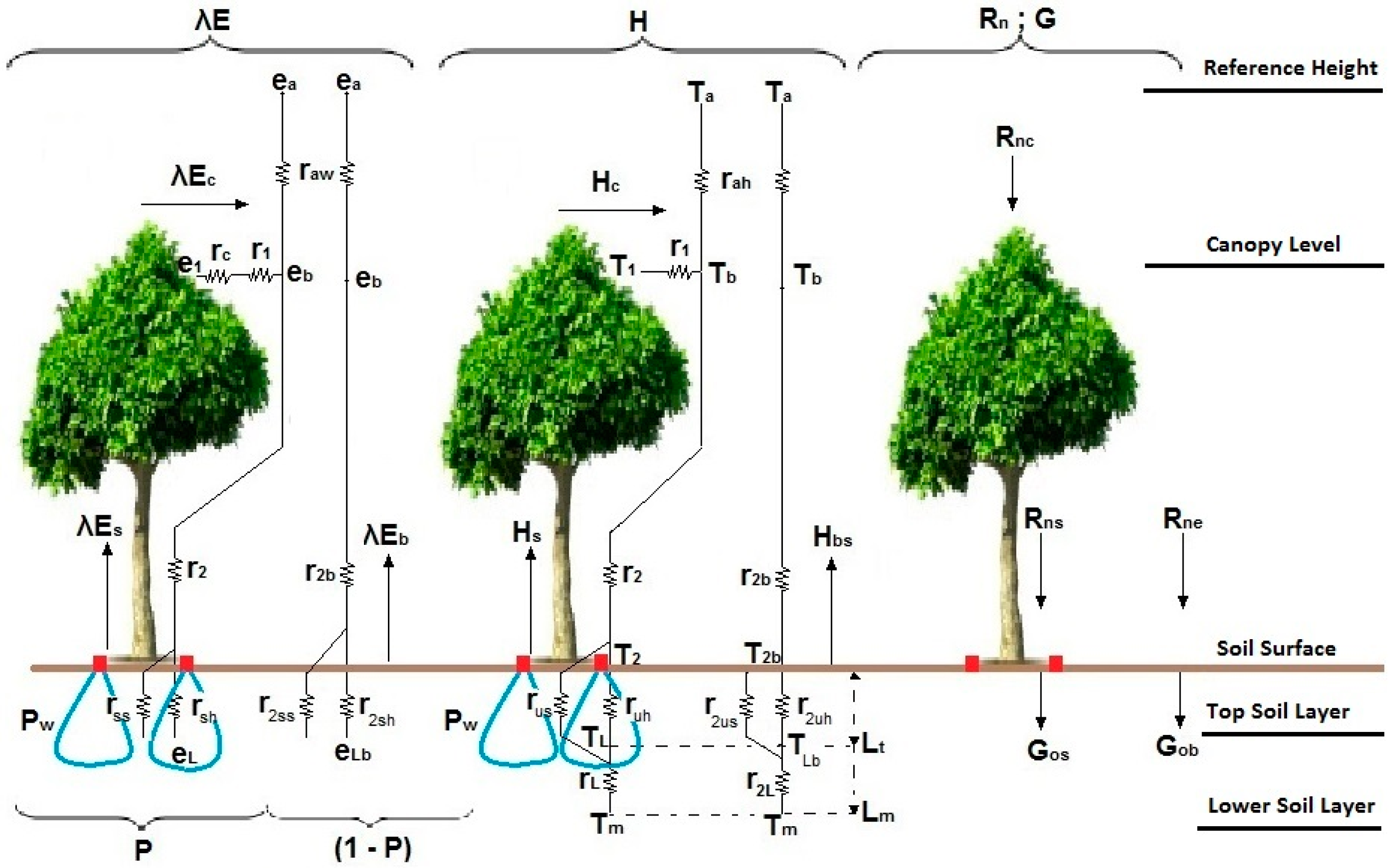
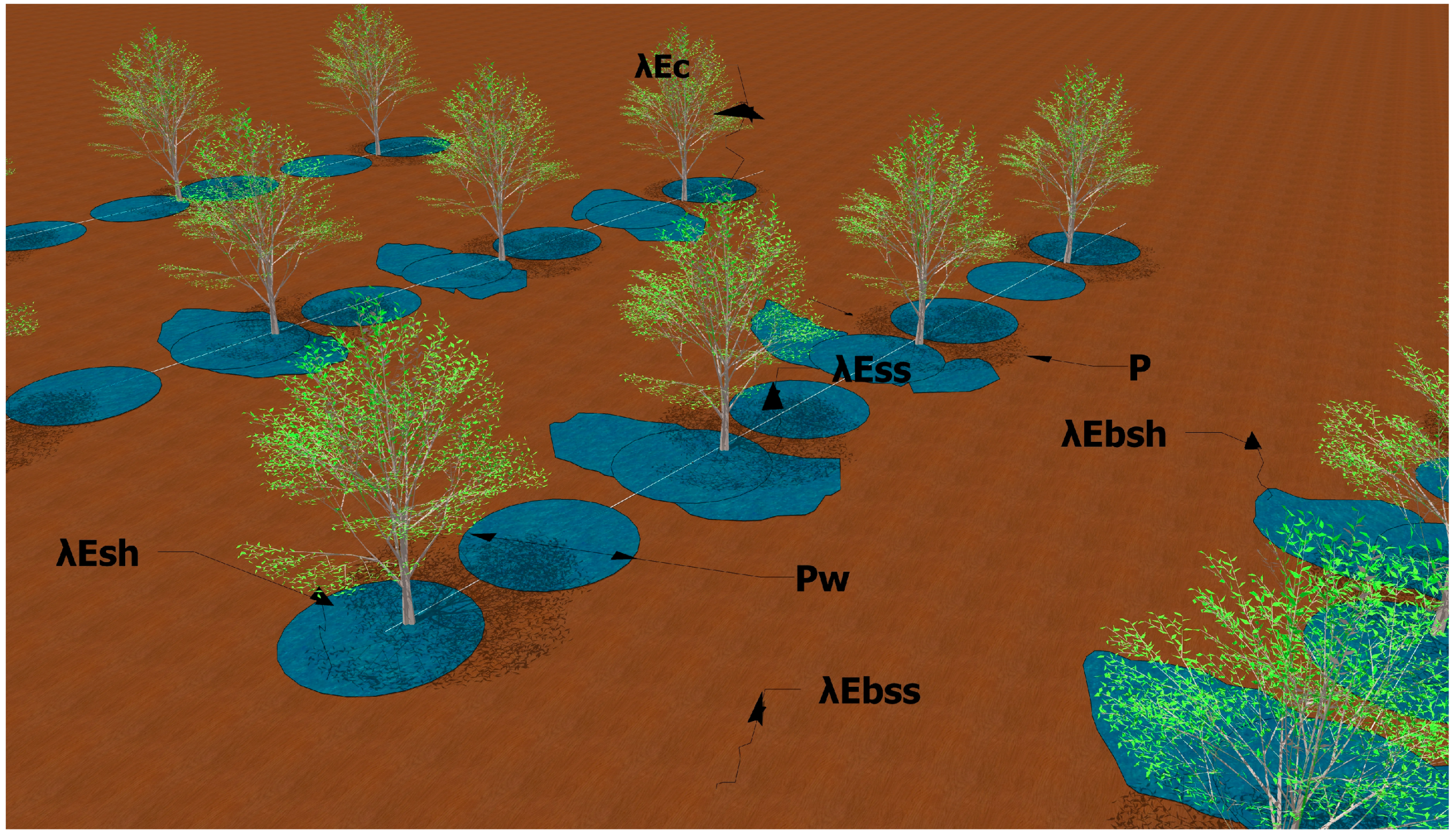
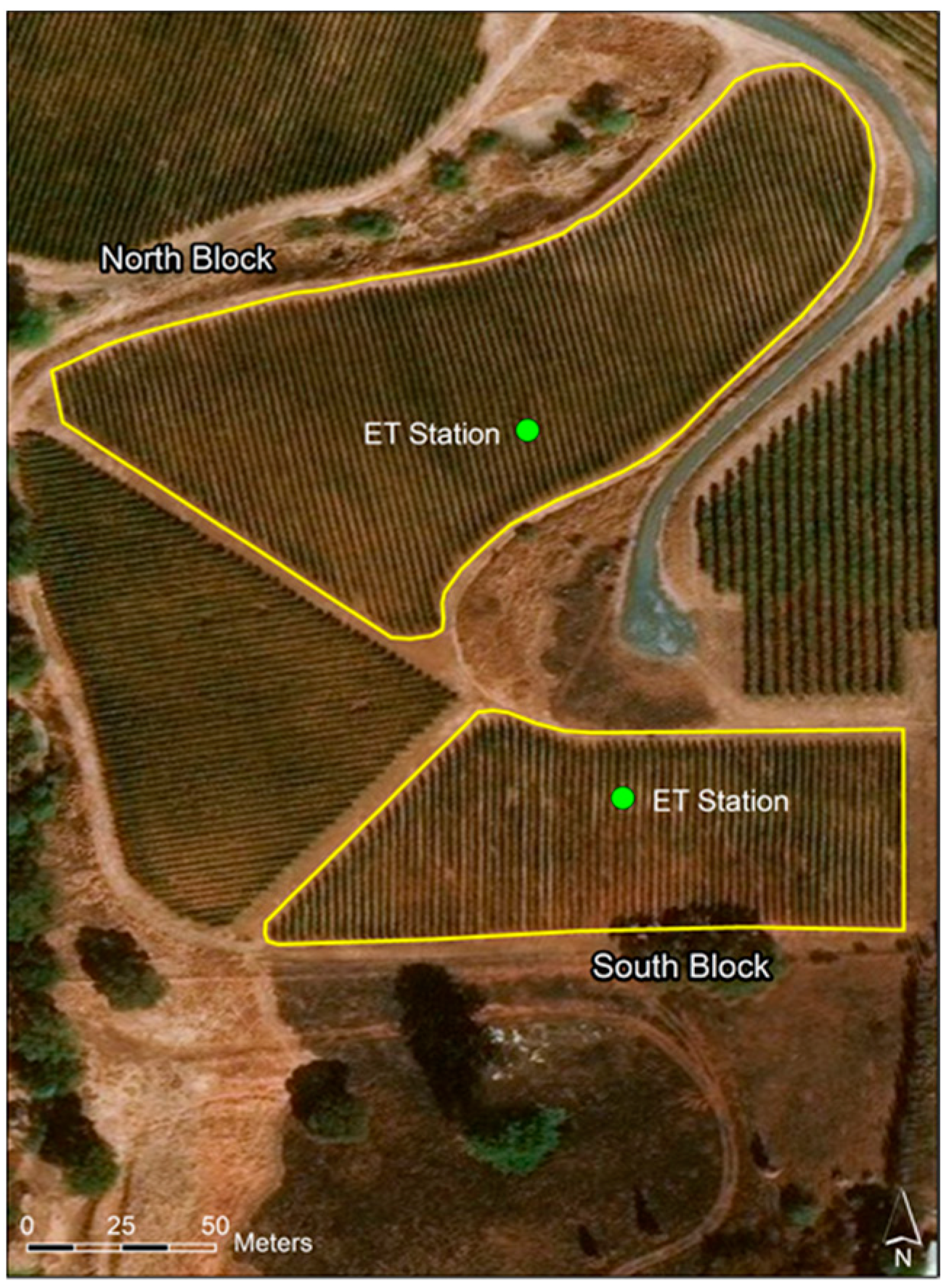
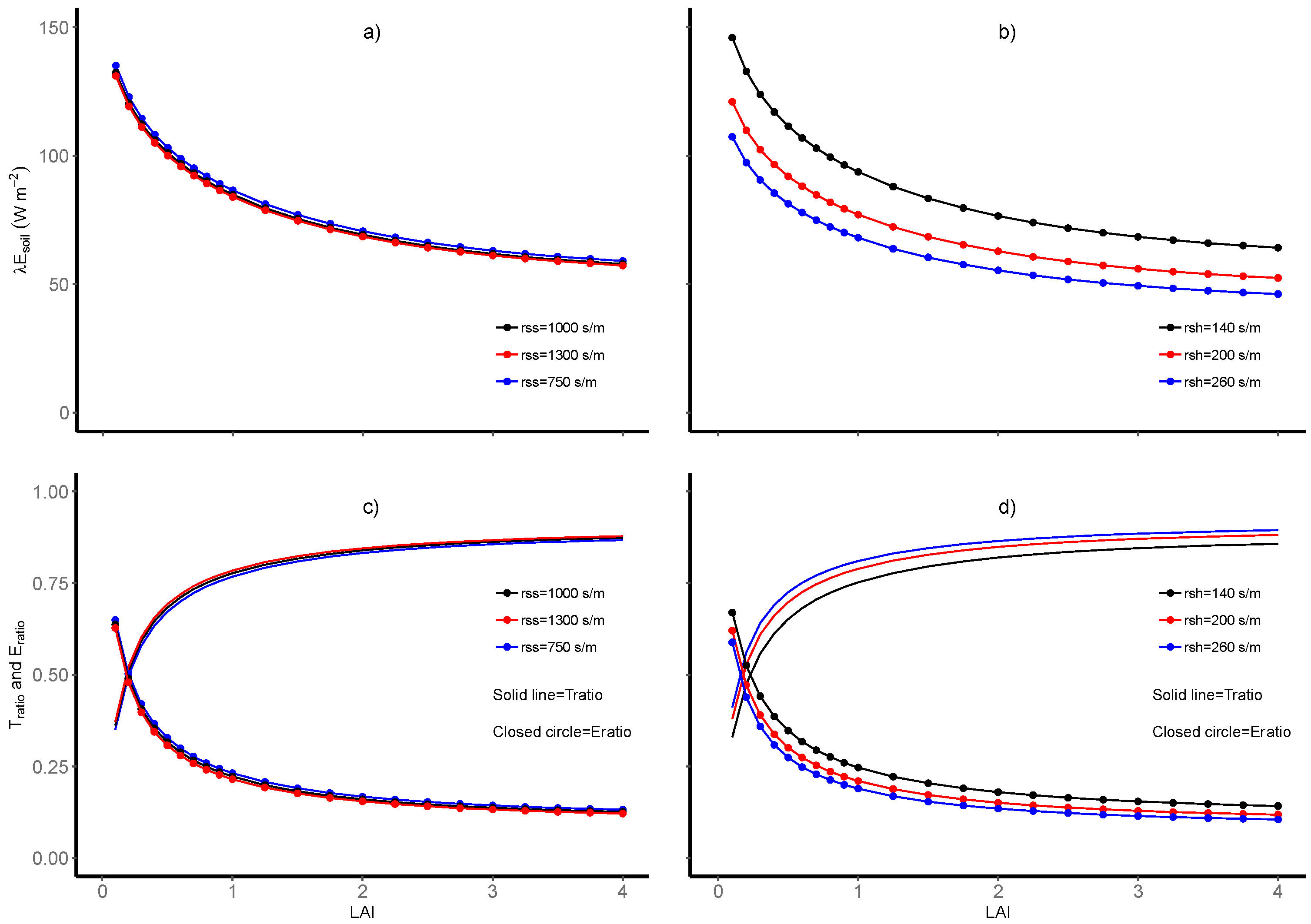
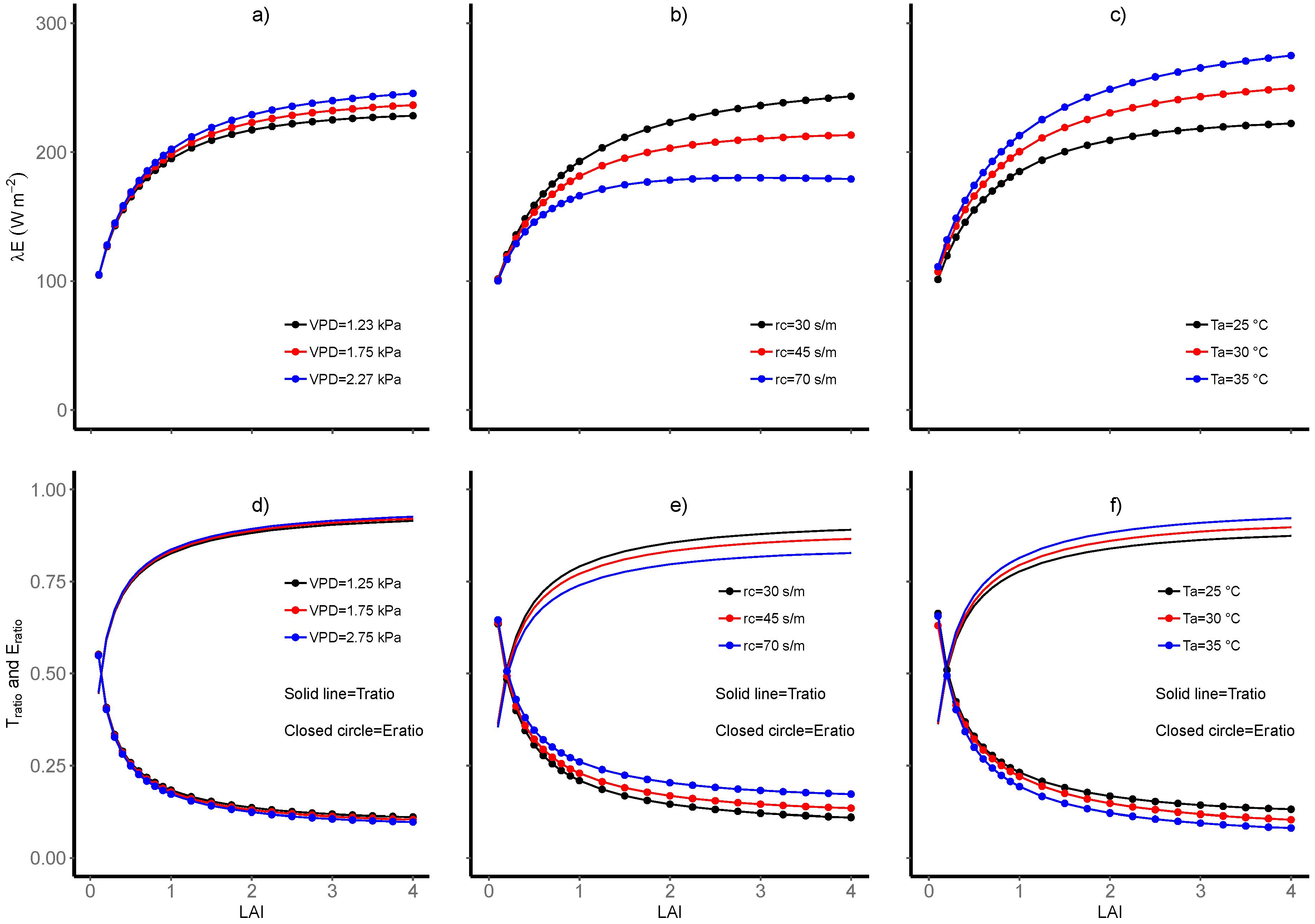
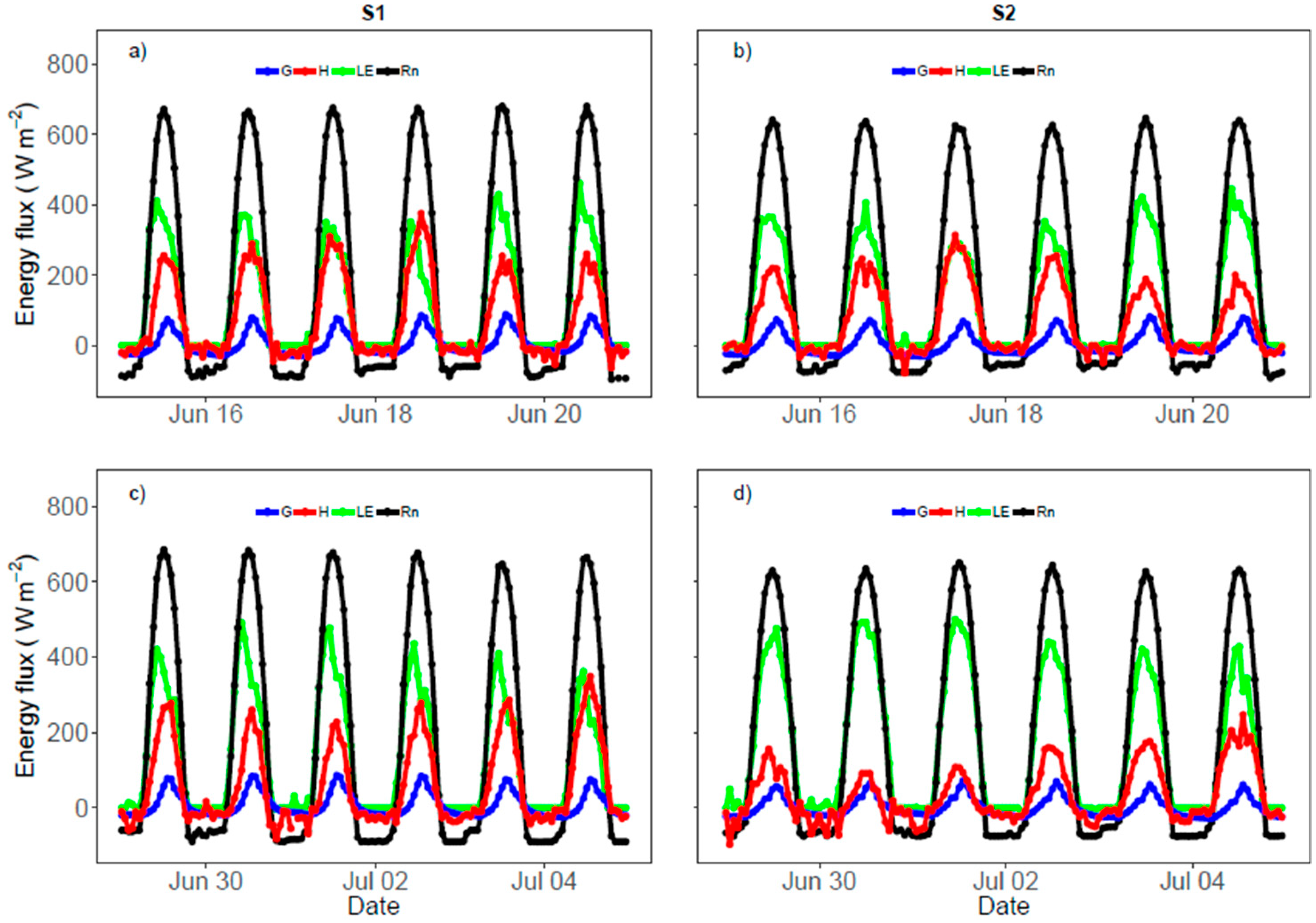
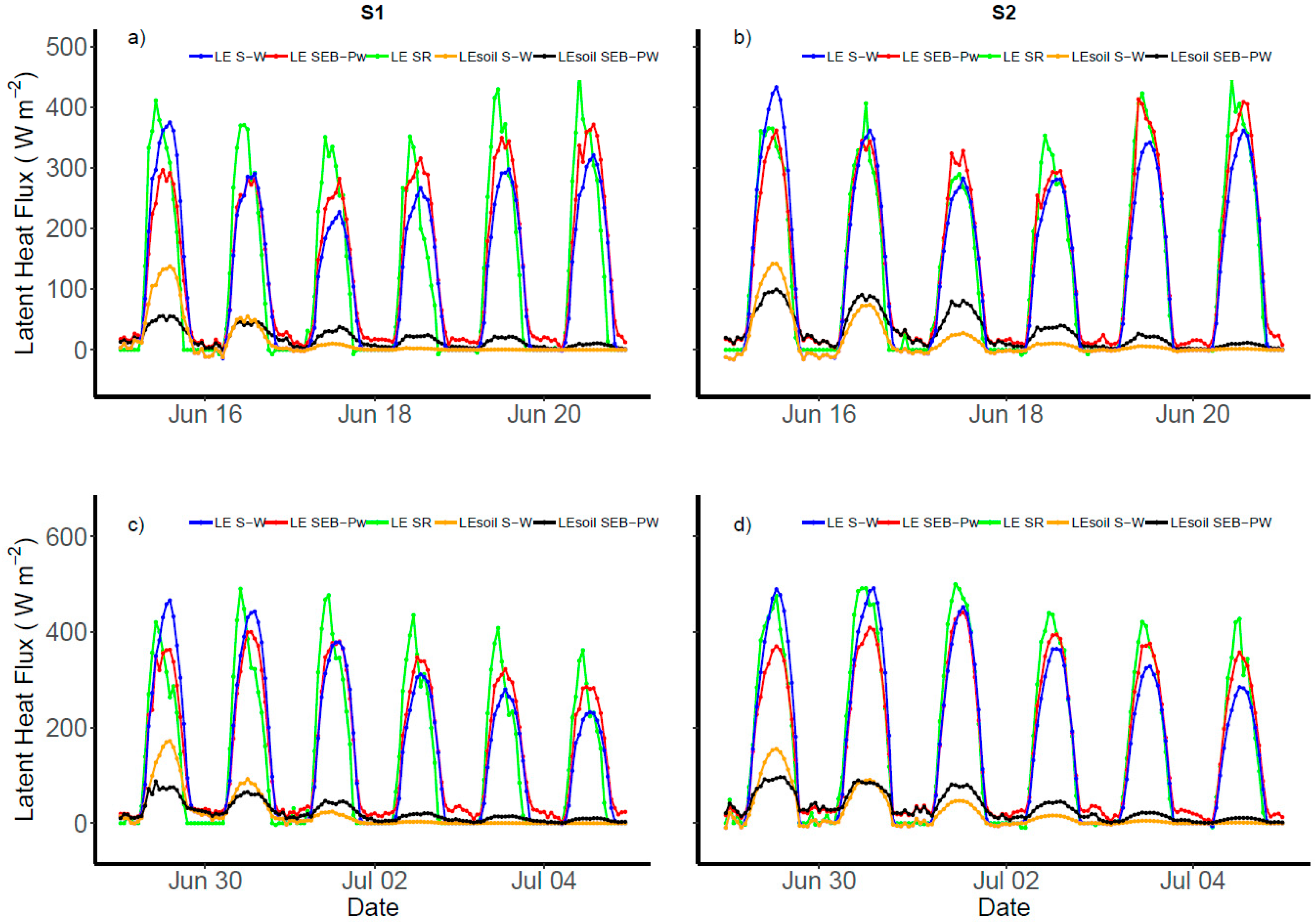
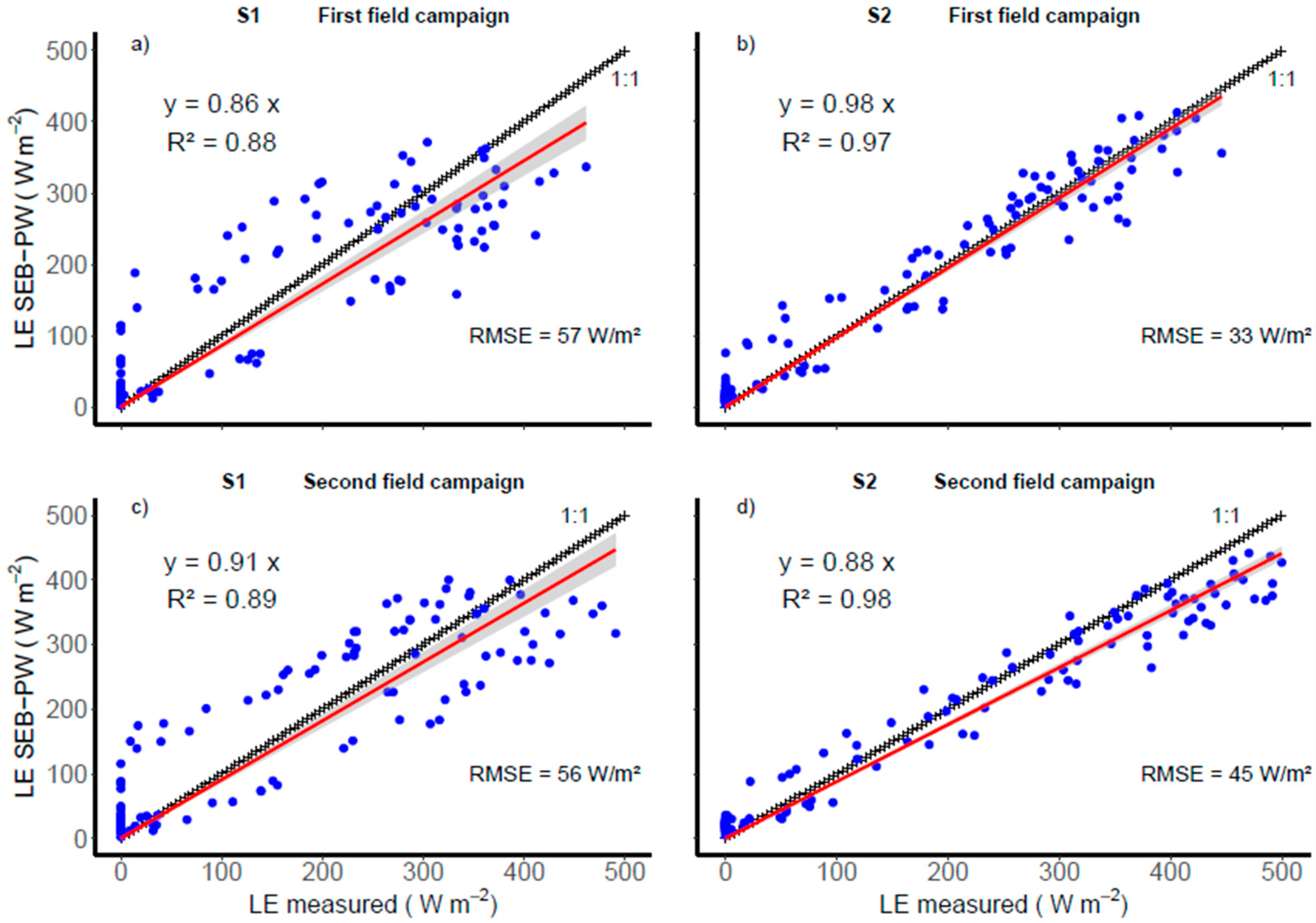
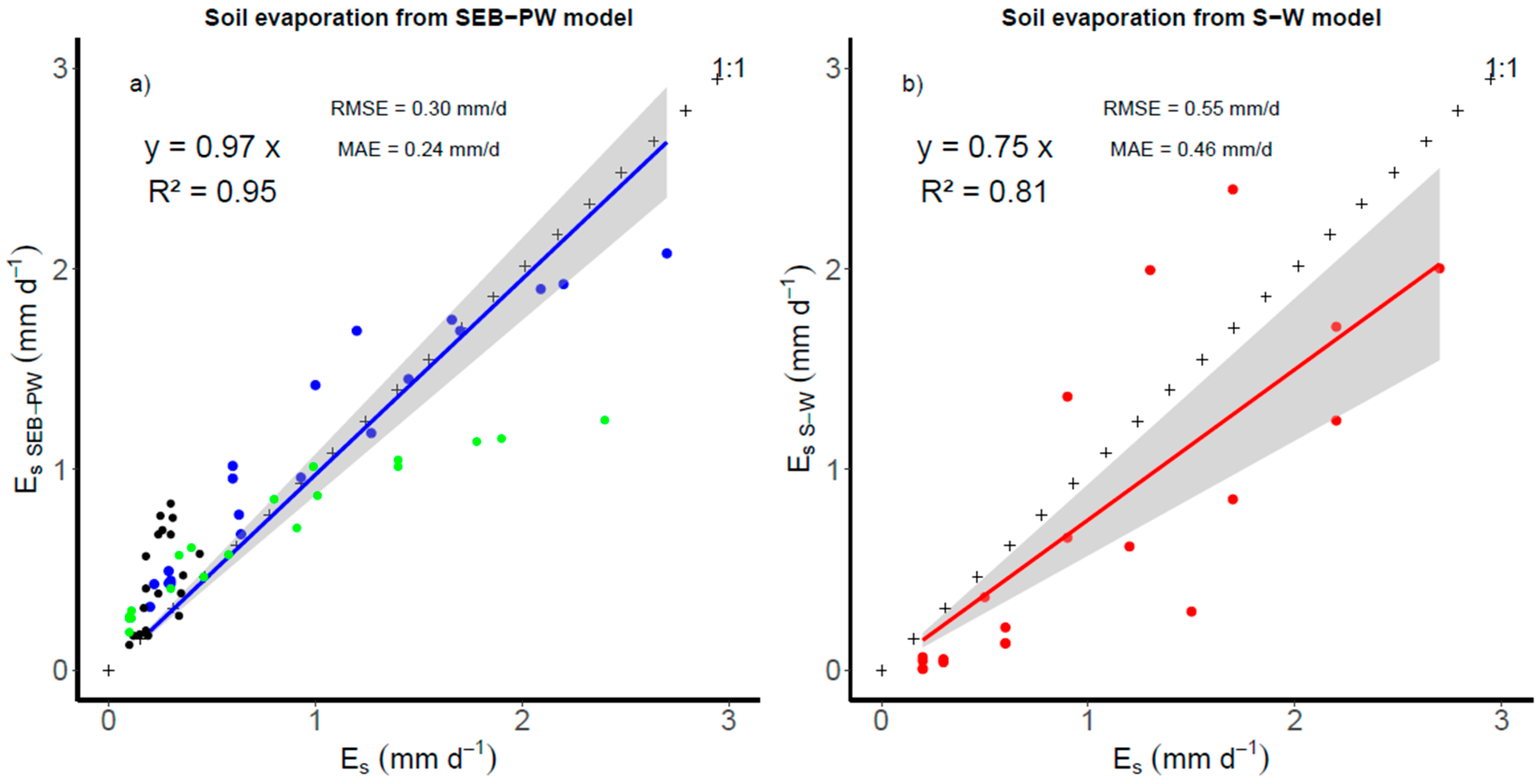
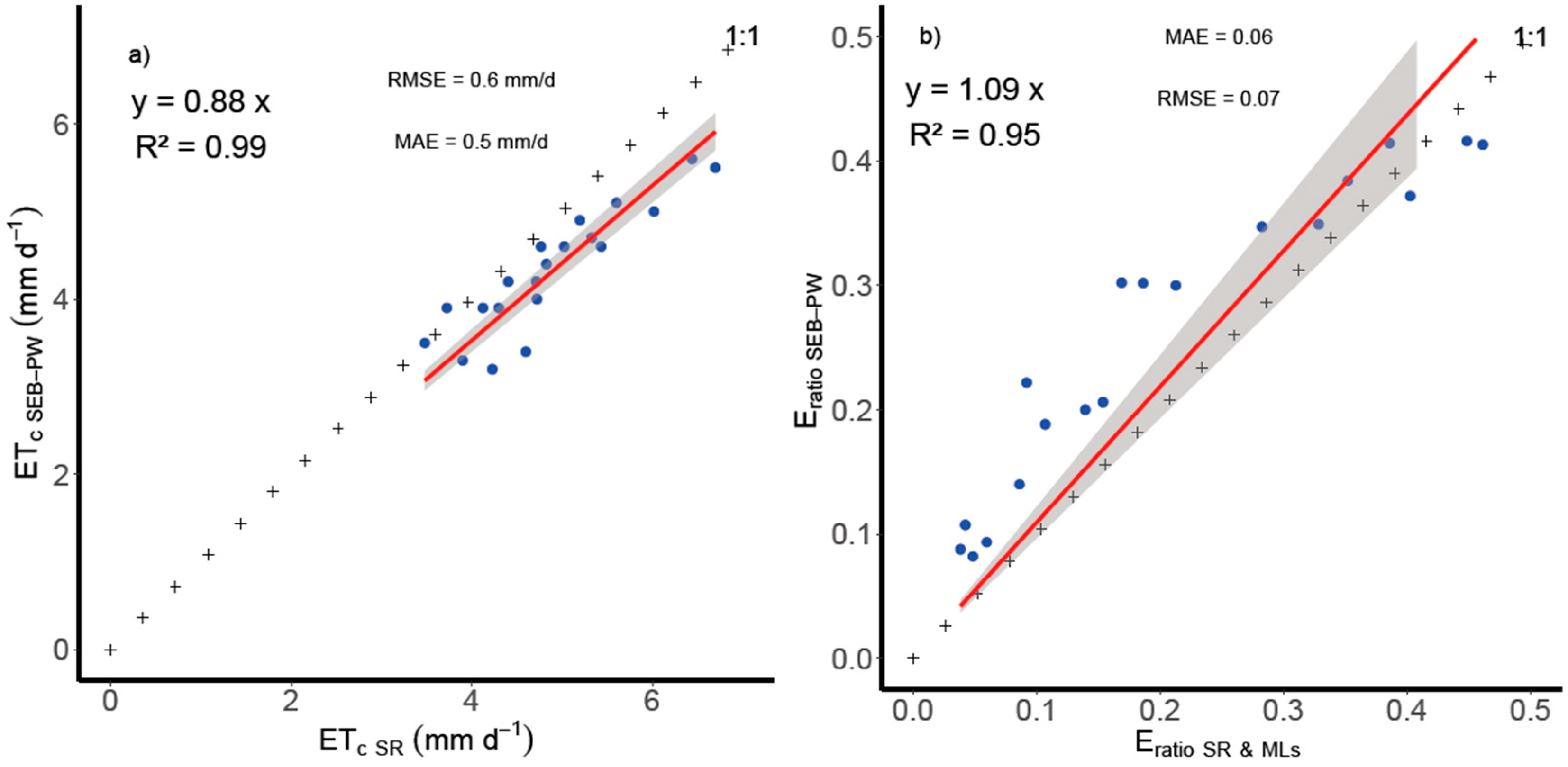
| Variable | S1 | S2 |
|---|---|---|
| Plantation year | 2000 | |
| Density of vines (vines ha−1) | 3703 | |
| Spacing (m × m) | 1.8 × 1.5 | |
| Height of the canopy (m) | 1.5 | 2.0 |
| Size block (ha) | 0.6 | 1.0 |
| Depth of soil (m) | 0.6 | |
| (m3·m−3) 1 | 0.213 | 0.196 |
| (m3·m−3) 1 | 0.350 | 0.346 |
| (kg·m−3) 1 | 1.40 | 1.38 |
| Topographic slope (%) | 25.4 | 24.5 |
| System application rate (mm h−1) | 1.65 | 1.73 |
| (L h−1) | 2.3 | 2.4 |
| 0.87 | 0.86 | |
| S1 | S2 | |||||
|---|---|---|---|---|---|---|
| Date (m/d/y) | Ta avg (°C) | uavg (m s−1) | SWT (cbar) | Ta avg (°C) | uavg (m s−1) | SWT (cbar) |
| 6/15/2018 | 21.8 | 2.2 | 58 | 21.1 | 1.1 | 25 |
| 6/16/2018 | 19.1 | 2.5 | 70 | 19.0 | 1.2 | 36 |
| 6/17/2018 | 15.7 | 1.8 | 82 | 15.7 | 1.1 | 45 |
| 6/18/2018 | 20.3 | 1.7 | 95 | 19.3 | 1.7 | 54 |
| 6/19/2018 | 23.3 | 1.6 | 107 | 22.8 | 1.0 | 62 |
| 6/20/2018 | 24.0 | 1.9 | 110 | 23.7 | 1.1 | 70 |
| S1 | S2 | |||||
| 6/29/2018 | 23.8 | 1.3 | 17 | 23.2 | 1.8 | 2 |
| 6/30/2018 | 27.0 | 1.8 | 27 | 26.2 | 2.0 | 10 |
| 7/1/2018 | 27.5 | 1.7 | 35 | 26.9 | 1.2 | 15 |
| 7/2/2018 | 24.3 | 1.8 | 44 | 24.0 | 1.1 | 19 |
| 7/3/2018 | 21.6 | 2.0 | 52 | 21.6 | 1.1 | 23 |
| 7/4/2018 | 18.6 | 1.7 | 61 | 18.3 | 1.0 | 27 |
© 2019 by the authors. Licensee MDPI, Basel, Switzerland. This article is an open access article distributed under the terms and conditions of the Creative Commons Attribution (CC BY) license (http://creativecommons.org/licenses/by/4.0/).
Share and Cite
Souto, C.; Lagos, O.; Holzapfel, E.; Maskey, M.L.; Wunderlich, L.; Shapiro, K.; Marino, G.; Snyder, R.; Zaccaria, D. A Modified Surface Energy Balance to Estimate Crop Transpiration and Soil Evaporation in Micro-Irrigated Orchards. Water 2019, 11, 1747. https://doi.org/10.3390/w11091747
Souto C, Lagos O, Holzapfel E, Maskey ML, Wunderlich L, Shapiro K, Marino G, Snyder R, Zaccaria D. A Modified Surface Energy Balance to Estimate Crop Transpiration and Soil Evaporation in Micro-Irrigated Orchards. Water. 2019; 11(9):1747. https://doi.org/10.3390/w11091747
Chicago/Turabian StyleSouto, Camilo, Octavio Lagos, Eduardo Holzapfel, Mahesh Lal Maskey, Lynn Wunderlich, Kristen Shapiro, Giulia Marino, Richard Snyder, and Daniele Zaccaria. 2019. "A Modified Surface Energy Balance to Estimate Crop Transpiration and Soil Evaporation in Micro-Irrigated Orchards" Water 11, no. 9: 1747. https://doi.org/10.3390/w11091747
APA StyleSouto, C., Lagos, O., Holzapfel, E., Maskey, M. L., Wunderlich, L., Shapiro, K., Marino, G., Snyder, R., & Zaccaria, D. (2019). A Modified Surface Energy Balance to Estimate Crop Transpiration and Soil Evaporation in Micro-Irrigated Orchards. Water, 11(9), 1747. https://doi.org/10.3390/w11091747







